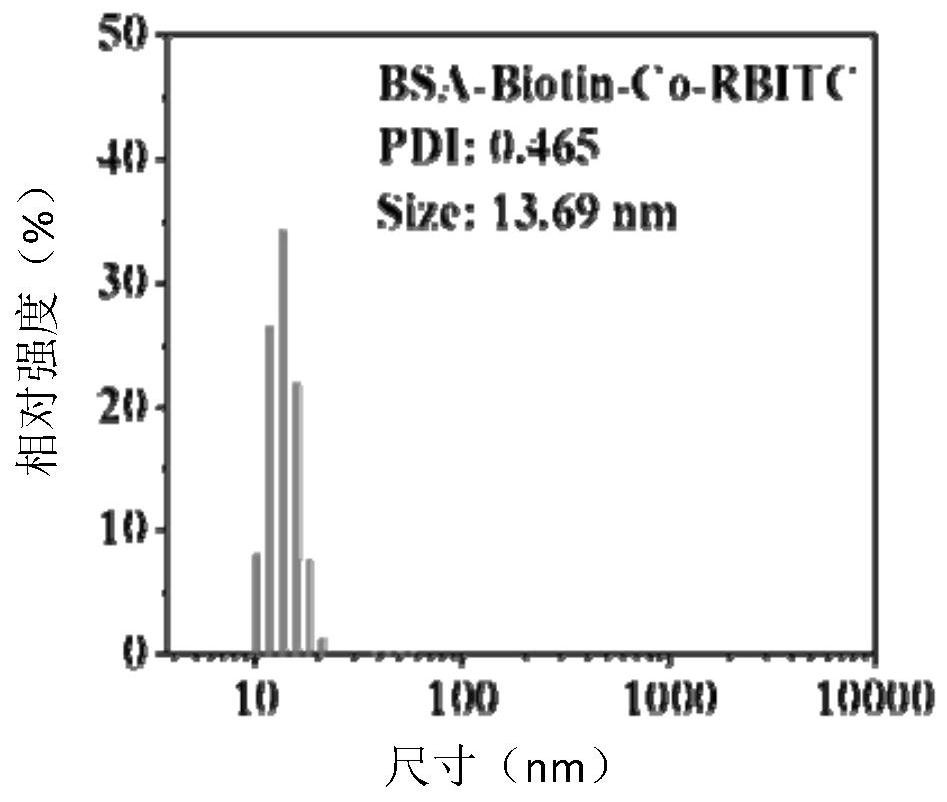Cobalt-based mimic enzyme as well as preparation method and application thereof
A technology that simulates enzymes and cobalt bases. It is applied in chemical instruments and methods, nanotechnology for materials and surface science, and analysis by making materials undergo chemical reactions. It can solve problems such as poor biocompatibility and achieve catalytic decomposition. , The effect of excellent simulated enzyme characteristics and strong catalytic ability
- Summary
- Abstract
- Description
- Claims
- Application Information
AI Technical Summary
Problems solved by technology
Method used
Image
Examples
Embodiment 1
[0047] Preparation of cobalt-based nanozymes
[0048] 1) Add bovine serum albumin (hereinafter referred to as BSA) to a final concentration of 10 grams per liter into 0.1 moles per liter and a pH of 8 sodium bicarbonate buffer solution, stir and dissolve completely and take 6 milliliters of BSA in carbonic acid Sodium hydrogen solution, move in the 20 milliliter reaction bottle, add 0.6 milliliter concentration afterward and be the cobalt chloride solution of 0.4 mole per liter and mix and react for 5 minutes,
[0049] 2) Add 0.3 milliliters of glutathione aqueous solution with a concentration of 0.1 moles per liter to the solution obtained in the above step 1) to assist in the formation of crystal grains, then continue vigorously stirring at a constant temperature of 37 degrees Celsius for 4 hours, and then let it stand for 12 Hour aging followed by dialysis for 3 days using dialysis bags with a molecular weight cut-off of 10,000.
[0050] The prepared cobalt-based nanozyme ...
Embodiment 2
[0053] 1) Add ovalbumin to a sodium bicarbonate buffer solution with a final concentration of 20 grams per liter and a pH of 7.5 at a concentration of 0.1 mole per liter. After stirring and dissolving completely, take 6 milliliters of the sodium bicarbonate solution of BSA and transfer it to 20 milliliters In the reaction flask, add 0.3 ml of cobalt chloride solution with a concentration of 0.2 moles per liter and mix for 5 minutes;
[0054] 2) To the solution obtained in the above step 1), add 0.6 milliliters of cysteine aqueous solution with a concentration of 0.05 moles per liter to assist the formation of crystal grains, then continue to stir vigorously at a constant temperature at 37 degrees Celsius for 6 hours, and then let it stand for 8 hours. Hour aging followed by dialysis for 2 days using a dialysis bag with a molecular weight cut off of 8000.
[0055] The cobalt-based nanozyme prepared in this example was also characterized by dynamic light scattering, and the av...
Embodiment 3
[0057] 1) Human serum albumin is added to the sodium bicarbonate buffer solution of 0.1 mole per liter and pH of 6 with a final concentration of 5 grams per liter, after stirring and dissolving completely, get the sodium bicarbonate solution of 6 milliliters of BSA, and move it into 20 In the milliliter reaction flask, add 0.3 milliliter concentration and be the cobalt sulfate solution of 0.05 mole per liter and mix and react for 10 minutes;
[0058] 2) To the solution obtained in the above step 1), add 0.6 milliliters of cysteine aqueous solution with a concentration of 0.05 moles per liter to assist the formation of crystal grains, then continue to stir vigorously at a constant temperature at 37 degrees Celsius for 1 hour, and then let it stand for 12 Hour aging followed by dialysis for 1 day using a dialysis bag with a molecular weight cut-off of 15,000.
[0059] The cobalt-based nanozyme prepared in this example was also characterized by dynamic light scattering, and the...
PUM
| Property | Measurement | Unit |
|---|---|---|
| particle diameter | aaaaa | aaaaa |
| particle size | aaaaa | aaaaa |
| particle size | aaaaa | aaaaa |
Abstract
Description
Claims
Application Information
 Login to View More
Login to View More - R&D
- Intellectual Property
- Life Sciences
- Materials
- Tech Scout
- Unparalleled Data Quality
- Higher Quality Content
- 60% Fewer Hallucinations
Browse by: Latest US Patents, China's latest patents, Technical Efficacy Thesaurus, Application Domain, Technology Topic, Popular Technical Reports.
© 2025 PatSnap. All rights reserved.Legal|Privacy policy|Modern Slavery Act Transparency Statement|Sitemap|About US| Contact US: help@patsnap.com



